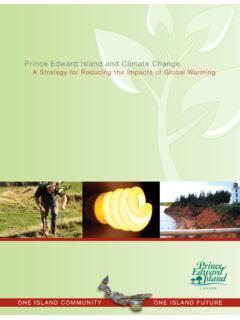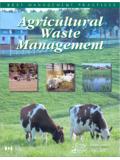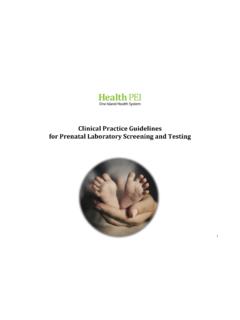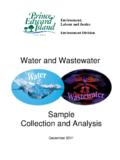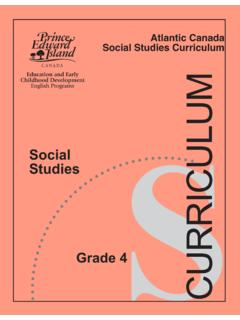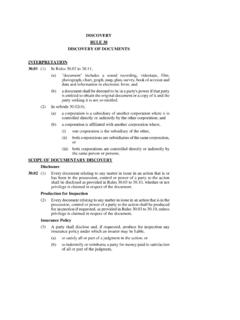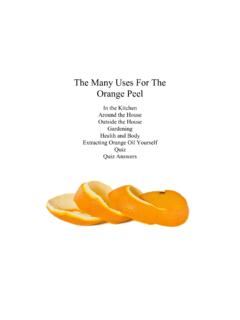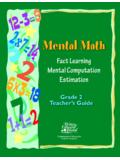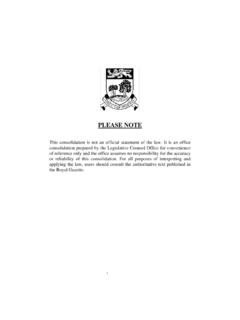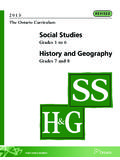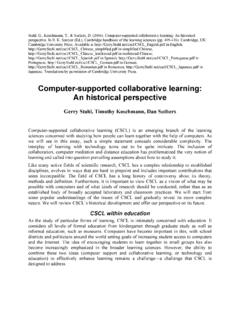Transcription of Physical Education Curriculum Guide, Grades K-6
1 IPEI DEPARTMENT OF Education AND EARLY CHILDHOOD DEVELOPMENT: Physical Education Curriculum , K-6 Table of iiiDeveloping Physical vTeacher 1 Broad Areas of Learning .. 2 Aim and Goals of K-6 Physical Education .. 3An Effective Physical Education Program .. 5 Counteracting 5 Constructing Understanding through 7 Meeting the Needs of All Students .. 1 1 1 Achieving Grade Specific Curricular 2 9 Assessment and Evaluation of Student 3 3 Considerations for Program Delivery .. 4 9 The Connection and Distinction between Dance in Physical Educationand Dance in Arts Education ..52 Kindergarten Physical Education Outcomes and 5 3 Grade 1 Physical Education Outcomes and 5 8 Grade 2 Physical Education Outcomes and 6 9 Grade 3 Physical Education Outcomes and 8 0 Grade 4 Physical Education Outcomes and 9 2 Grade 5 Physical Education Outcomes and 104 Grade 6 Physical Education Outcomes and 151 TABLE OF CONTENTSiiPEI DEPARTMENT OF Education AND EARLY CHILDHOOD DEVELOPMENT: Physical Education Curriculum , K-6iiiPEI DEPARTMENT OF Education AND EARLY CHILDHOOD DEVELOPMENT.
2 Physical Education Curriculum , K-6 ACKNOWLEDGMENTSC hris Meuse - West Royalty Elementary SchoolDave Matthews - Gulf Shore Consolidated SchoolKim McNeill - Elm Street Elementary SchoolCheryl Tanton - Somerset Elementary SchoolJacki Ross - Westwood Primary SchoolJohn Morrison - Department of Health and WellnessLori MacPherson - Department of Education and Early Childhood DevelopmentJacquie Lidstone - PEI Home and School RepresentativePilot TeachersChris Meuse - West Royalty Elementary SchoolDave Matthews - Gulf Shore Consolidated SchoolKim McNeill - Elm Street Elementary SchoolCheryl Tanton - Somerset Elementary SchoolJacki Ross - Westwood Primary SchoolRobyn MacDonald - Vernon River Consolidated SchoolThe Department of Education and Early Childhood Development is also grateful to the province ofSaskatchewan for granting permission to
3 Reproduce/adapt materials from the Saskatchewan PhysicalEducation K-6 Curriculum documents to assist us in the development of this Education . (2010) Kindergarten to Grade 6 Physical Education . Saskatchewan Ministry ofEducation: Curriculum and E-Learning, Humanities Unit).This Curriculum guide is intended to provide teachers with an overview of the outcomes frameworkfor K-6 Physical Education and to assist teachers in designing learning experiences and Department of Education and Early Childhood Development of Prince Edward Island gratefullyacknowledges the contributions of the elementary Physical Education Curriculum committee and the pilotteachers to the development of this Curriculum guide. Current and past members of the committee includethe following:AcknowledgmentsivPEI DEPARTMENT OF Education AND EARLY CHILDHOOD DEVELOPMENT: Physical Education Curriculum , K-6vPEI DEPARTMENT OF Education AND EARLY CHILDHOOD DEVELOPMENT: Physical Education Curriculum , K-6 Developing Physical LiteracyDeveloping Physical LiteracyDeveloping Physical LiteracyDeveloping Physical LiteracyDeveloping Physical LiteracyPhysical literacy can be described as the ability and motivation to capitalizeon our movement potential to make a significant contribution to our qualityof life.
4 As humans, we all exhibit this potential; however, its specificexpression will be particular to the culture in which we live and themovement capacities with which we are individual who is physically literate: moves with poise, economy, and confidence in a wide variety ofphysically challenging situations. is perceptive in reading all aspects of the Physical environment,anticipating movement needs or possibilities and responding appropriatelyto these, with intelligence and imagination. has a well-established sense of self as embodied in the world. This,together with an articulate interaction with the environment, engenderspositive self esteem and self confidence. develops fluency in self-expression through non-verbal communicationand perceptive and empathetic interaction with others. can identify and articulate the essential qualities that influence theeffectiveness of own movement performance, and has an understanding ofthe principles of embodied health, with respect to basic aspects such asexercise, sleep, and nutrition.
5 (Whitehead, 2006)viPEI DEPARTMENT OF Education AND EARLY CHILDHOOD DEVELOPMENT: Physical Education Curriculum , K-6viiPEI DEPARTMENT OF Education AND EARLY CHILDHOOD DEVELOPMENT: Physical Education Curriculum , K-6 Teacher Notes:Percentage of time for elementary Physical Education Curriculum Grades K-6: 5% (15 minutes/day, 75minutes/week, 90 minutes/6-day cycle, or hours/year)Authorized Resources for 2011 Grades K-6 Elementary Physical Education Curriculum :Fundamental Movement Skills Series - (5 titles)Fundamental Movement Skills: Active Start and Fundamentals HandbookFundamental Movement Skills II: Learning to Train StageFundamental Movement Skills IA: For Children with Physical DisabilitiesFundamental Movement Skills: Active Start and Fundamental Stages - For Children withDevelopmental and/or Behavioural DisabilitiesFundamental Movement Skills: Beyond the Fundamentals - A Games ApproachKidnasticsMore Fun and GamesNo Standing around in My GymTeaching Sport Concepts and Skills - 2nd , Level One Basic Skills SeriesTeaching Personal and Social Responsibility through Physical Activity - 3rd Edward Island Physical Education Curriculum Guide, Grades K-6 The following titles were purchased by the Department of Education and Early Childhod Developmentover the past few years and distributed to all elementary schools.
6 These were one time only Active Living Fitness Circuit Charts101 Games to Play in a New WayEnergize: LD-ENGI ntramural RecreationPlayground LeadershipConvenorology: So You Want to Be a ConvenorIntramuralology: A Quick Reference Guide for Intramural ProgramsFun FirstPhysical Education For Elementary School ChildrenReady-to-Use Activities for Grades K-2, 3-4, and 5-6A copy of the Prince Edward Island Physical Education Safety Guidelines document should be available in thegymnasium area. The intent of these guidelines is to focus the teacher s attention on safe instructionalpractices for all Physical activity in order to minimize the inherent element of risk. The guidelines links have been made throughout this document. These links are all based on thecurriculum that existed in subject areas when this document was being DEPARTMENT OF Education AND EARLY CHILDHOOD DEVELOPMENT: Physical Education Curriculum , K-61 PEI DEPARTMENT OF Education AND EARLY CHILDHOOD DEVELOPMENT: Physical Education Curriculum , K-6 Physical Education is a required area of study in Prince Edward Island score Curriculum .
7 The provincial requirement for Grades K-6 PhysicalEducation is a minimum of 75 minutes of instruction per week or 90minutes per 6-day cycle for the entire school year in order to provideopportunities for students to develop positive attitudes toward activeliving, and gain self-confidence as skilful movers, and to promote personal,social, cultural, and environmental growth and appreciation. Qualityphysical Education , as part of the entire learning experience concernedwith educating the whole person, will support students in developing asolid foundation for a balanced Curriculum provides the intended learning outcomes that Grades K-6 students are expected to achieve in Physical Education by the end ofeach year. Indicators are included to provide the breadth and depth oflearning required by the Physical Education Curriculum provides the critical characteristics and philosophical foundations of effectivephysical Education programs; the learning outcomes for Grades K-6 Physical Education that arebased on research; indicators related to the outcomes ( , evidence of studentunderstanding) to enable teachers to assess the degree to whichstudents have achieved each outcome; sample assessment rubrics and evaluation guide for physicaleducation.
8 Ideas for connecting Physical Education with other subject Curriculum also provides an introduction to pedagogicalunderstandings necessary for the effective teaching of Physical support theinclusion of Physical Education inthe overall educational experiencesof children and illustrate the valueof Physical Education in the holisticdevelopment of students.(Hickson & Fisburne, , p. 6)Students who are physically educatedare: Able to make connectionsbetween all aspects of humannature ( Physical , emotional,mental, and spiritual) Working towards balance,harmony, and interconnectednesson their journey Persevering, setting goals,learning patience, enjoying thebenefits of a physically activelifestyle that leads to a state ofwholeness and wellness andsharing this knowledge withothers.(Kalyn, 2006, p. 195)2 PEI DEPARTMENT OF Education AND EARLY CHILDHOOD DEVELOPMENT: Physical Education Curriculum , K-6 Lifelong LearnersStudents who are engaged in constructing and applying physicaleducation knowledge naturally build the ability to continue learningin this area of study.
9 Throughout their study of Physical Education ,students will develop a holistic balance in the attitudes,understandings, skills, tactics, and strategies necessary to learn invarious movement activity settings. Students will develop skills intransferring this learning to a variety of contexts which will supportthem as lifelong of Self, Community, and PlaceIn Physical Education students will experience multiple opportunitiesto grow in all aspects of their lives, while learning to share theseunderstandings as they support others in achieving a balanced self. Instriving for this balance, students will be better able to contribute tothe development of healthy individuals, families, and CitizensIn Physical Education students will experience opportunities toinitiate, plan for, and lead positive change that will enhance thepersonal well-being of self and others.
10 Students will reflect on thevarious influences that affect decisions and engage in opportunities tocontribute to social, cultural, and environmental activities that willbenefit all Social ResponsibilityPeople demonstrate social responsibility when they positivelycontribute to their Physical , social, and cultural environments. Thisrequires the ability to participate with others in accomplishingcommon goals. This competency is achieved through using moralreasoning processes, engaging in communitarian thinking anddialogue, and taking social action. In Physical Education , students willdevelop personal skills to support socially responsible behaviour thatis considerate of others and respectful of individual Areas ofLearning3 PEI DEPARTMENT OF Education AND EARLY CHILDHOOD DEVELOPMENT: Physical Education Curriculum , K-6 The aim of the Physical Education Curriculum is to provideopportunities for students to develop knowledge, skills, and positiveattitudes toward active living.
